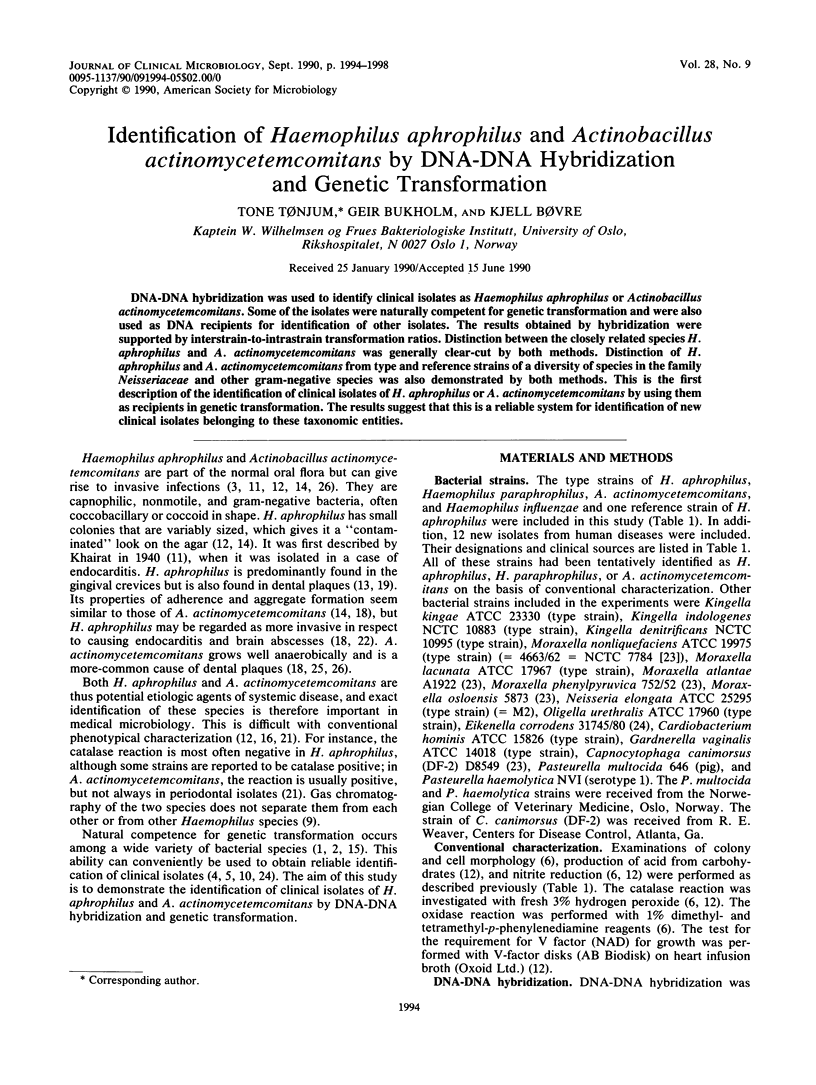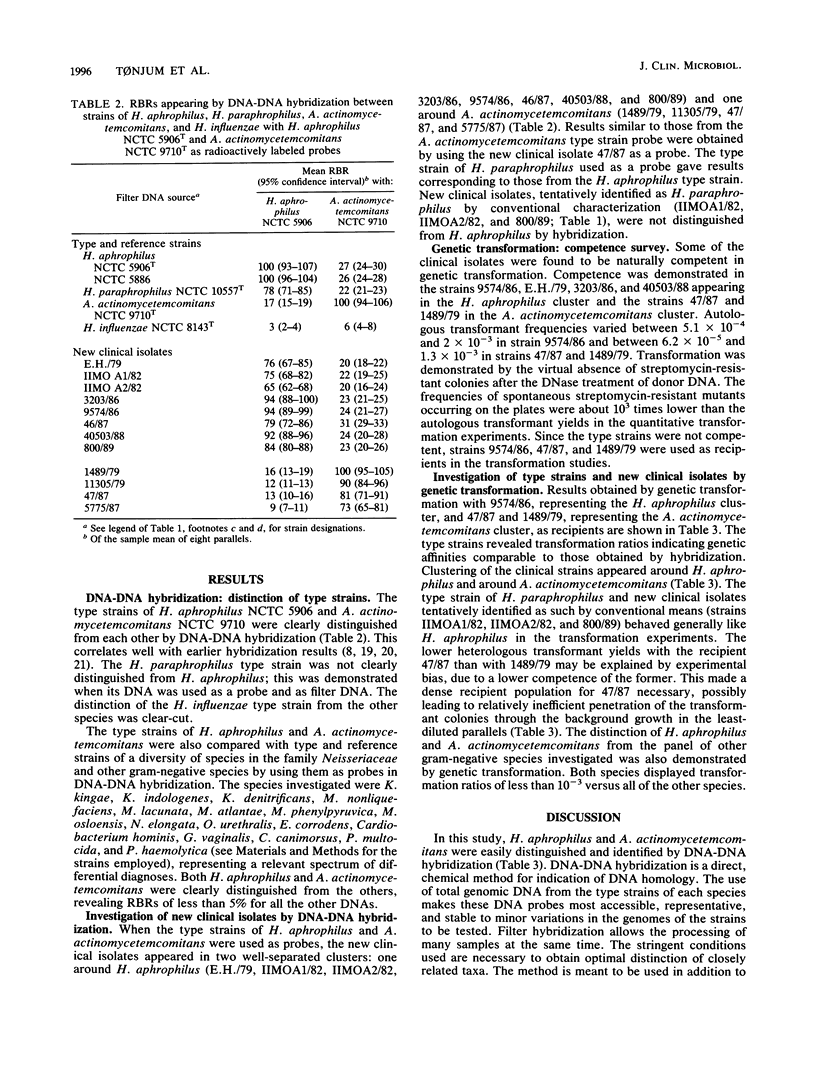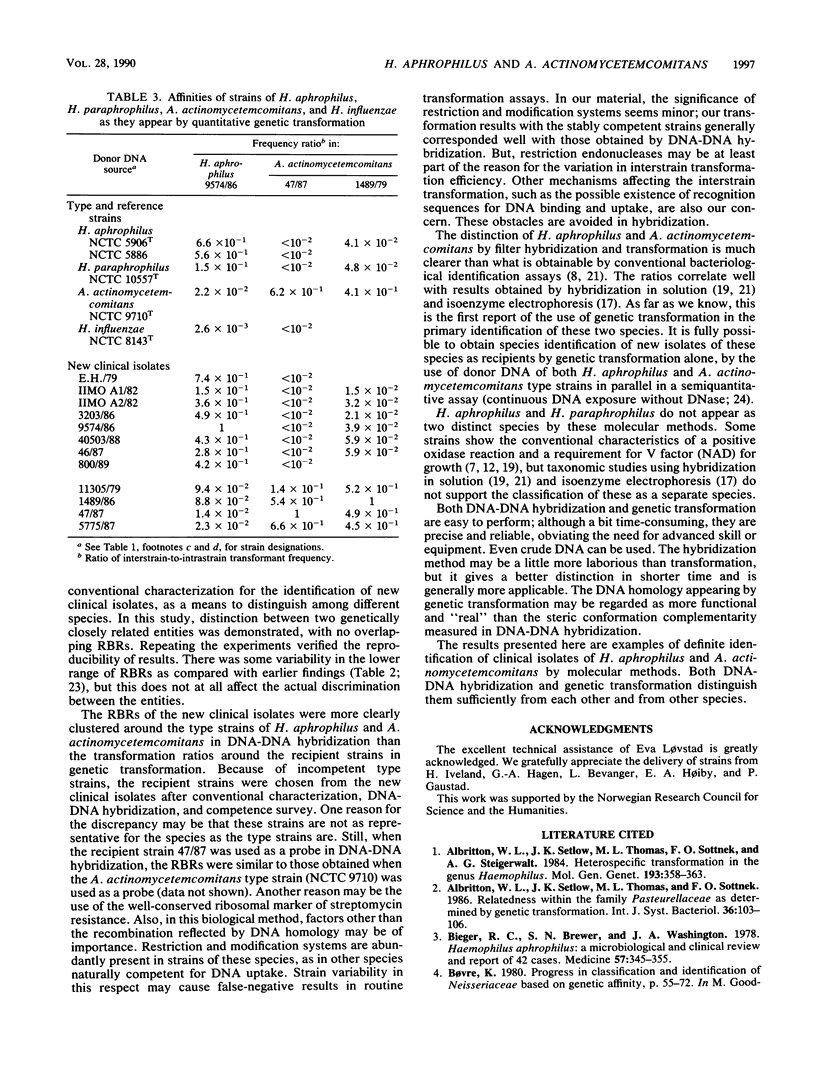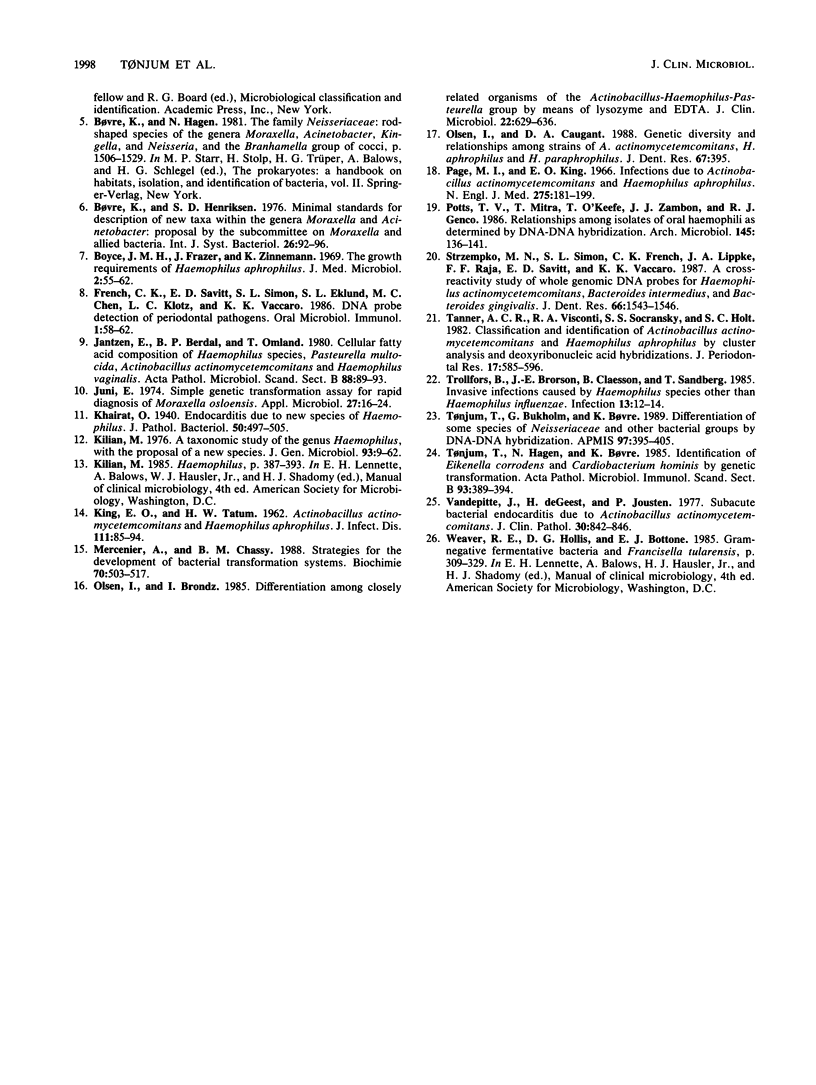Abstract
DNA-DNA hybridization was used to identify clinical isolates as Haemophilus aphrophilus or Actinobacillus actinomycetemcomitans. Some of the isolates were naturally competent for genetic transformation and were also used as DNA recipients for identification of other isolates. The results obtained by hybridization were supported by interstrain-to-intrastrain transformation ratios. Distinction between the closely related species H. aphrophilus and A. actinomycetemcomitans was generally clear-cut by both methods. Distinction of H. aphrophilus and A. actinomycetemcomitans from type and reference strains of a diversity of species in the family Neisseriaceae and other gram-negative species was also demonstrated by both methods. This is the first description of the identification of clinical isolates of H. aphrophilus or A. actinomycetemcomitans by using them as recipients in genetic transformation. The results suggest that this is a reliable system for identification of new clinical isolates belonging to these taxonomic entities.
Full text
PDF




Selected References
These references are in PubMed. This may not be the complete list of references from this article.
- Albritton W. L., Setlow J. K., Thomas M., Sottnek F., Steigerwalt A. G. Heterospecific transformation in the genus Haemophilus. Mol Gen Genet. 1984;193(2):358–363. doi: 10.1007/BF00330693. [DOI] [PubMed] [Google Scholar]
- Bieger R. C., Brewer N. S., Washington J. A., 2nd Haemophilus aphrophilus: a microbiologic and clinical review and report of 42 cases. Medicine (Baltimore) 1978 Jul;57(4):345–355. [PubMed] [Google Scholar]
- Boyce J. M., Frazur J., Zinnemann K. The growth requirements of Haemophillus aphrophillus. J Med Microbiol. 1969 Feb;2(1):55–62. doi: 10.1099/00222615-2-1-55. [DOI] [PubMed] [Google Scholar]
- French C. K., Savitt E. D., Simon S. L., Eklund S. M., Chen M. C., Klotz L. C., Vaccaro K. K. DNA probe detection of periodontal pathogens. Oral Microbiol Immunol. 1986 Nov;1(1):58–62. doi: 10.1111/j.1399-302x.1986.tb00320.x. [DOI] [PubMed] [Google Scholar]
- Jantzen E., Berdal B. P., Omland T. Cellular fatty acid composition of Haemophilus species, Pasteurella multocida, Actinobacillus Actinomycetemcomitans and Haemophilus vaginalis (Corynebacterium vaginale). Acta Pathol Microbiol Scand B. 1980 Apr;88(2):89–93. doi: 10.1111/j.1699-0463.1980.tb02611.x. [DOI] [PubMed] [Google Scholar]
- Juni E. Simple genetic transformation assay for rapid diagnosis of Moraxella osloensis. Appl Microbiol. 1974 Jan;27(1):16–24. doi: 10.1128/am.27.1.16-24.1974. [DOI] [PMC free article] [PubMed] [Google Scholar]
- KING E. O., TATUM H. W. Actinobacillus actinomycetemcomitans and Hemophilus aphrophilus. J Infect Dis. 1962 Sep-Oct;111:85–94. doi: 10.1093/infdis/111.2.85. [DOI] [PubMed] [Google Scholar]
- Kilian M. A taxonomic study of the genus Haemophilus, with the proposal of a new species. J Gen Microbiol. 1976 Mar;93(1):9–62. doi: 10.1099/00221287-93-1-9. [DOI] [PubMed] [Google Scholar]
- Mercenier A., Chassy B. M. Strategies for the development of bacterial transformation systems. Biochimie. 1988 Apr;70(4):503–517. doi: 10.1016/0300-9084(88)90086-7. [DOI] [PubMed] [Google Scholar]
- Olsen I., Brondz I. Differentiation among closely related organisms of the Actinobacillus-Haemophilus-Pasteurella group by means of lysozyme and EDTA. J Clin Microbiol. 1985 Oct;22(4):629–636. doi: 10.1128/jcm.22.4.629-636.1985. [DOI] [PMC free article] [PubMed] [Google Scholar]
- Page M. I., King E. O. Infection due to Actinobacillus actinomycetemcomitans and Haemophilus aphrophilus. N Engl J Med. 1966 Jul 28;275(4):181–188. doi: 10.1056/NEJM196607282750403. [DOI] [PubMed] [Google Scholar]
- Potts T. V., Mitra T., O'Keefe T., Zambon J. J., Genco R. J. Relationships among isolates of oral haemophili as determined by DNA-DNA hybridization. Arch Microbiol. 1986 Jul;145(2):136–141. doi: 10.1007/BF00446770. [DOI] [PubMed] [Google Scholar]
- Strzempko M. N., Simon S. L., French C. K., Lippke J. A., Raia F. F., Savitt E. D., Vaccaro K. K. A cross-reactivity study of whole genomic DNA probes for Haemophilus actinomycetemcomitans, Bacteroides intermedius, and Bacteroides gingivalis. J Dent Res. 1987 Oct;66(10):1543–1546. doi: 10.1177/00220345870660100601. [DOI] [PubMed] [Google Scholar]
- Tanner A. C., Visconti R. A., Socransky S. S., Holt S. C. Classification and identification of Actinobacillus actinomycetemcomitans and haemophilus aphrophilus by cluster analysis and deoxyribonucleic acid hybridizations. J Periodontal Res. 1982 Nov;17(6):585–596. doi: 10.1111/j.1600-0765.1982.tb01180.x. [DOI] [PubMed] [Google Scholar]
- Trollfors B., Brorson J. E., Claesson B., Sandberg T. Invasive infections caused by Haemophilus species other than Haemophilus influenzae. Infection. 1985 Jan-Feb;13(1):12–14. doi: 10.1007/BF01643614. [DOI] [PubMed] [Google Scholar]
- Tønjum T., Bukholm G., Bøvre K. Differentiation of some species of Neisseriaceae and other bacterial groups by DNA-DNA hybridization. APMIS. 1989 May;97(5):395–405. doi: 10.1111/j.1699-0463.1989.tb00806.x. [DOI] [PubMed] [Google Scholar]
- Tønjum T., Hagen N., Bøvre K. Identification of Eikenella corrodens and Cardiobacterium hominis by genetic transformation. Acta Pathol Microbiol Immunol Scand B. 1985 Dec;93(6):389–394. doi: 10.1111/j.1699-0463.1985.tb02907.x. [DOI] [PubMed] [Google Scholar]
- Vandepitte J., De Geest H., Jousten P. Subacute bacterial endocarditis due to Actinobacillus actinomycetemcomitans. Report of a case with a review of the literature. J Clin Pathol. 1977 Sep;30(9):842–846. doi: 10.1136/jcp.30.9.842. [DOI] [PMC free article] [PubMed] [Google Scholar]


